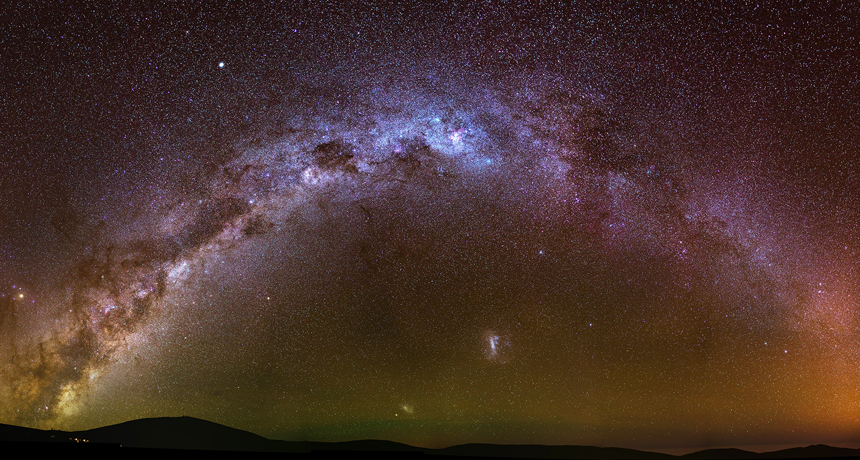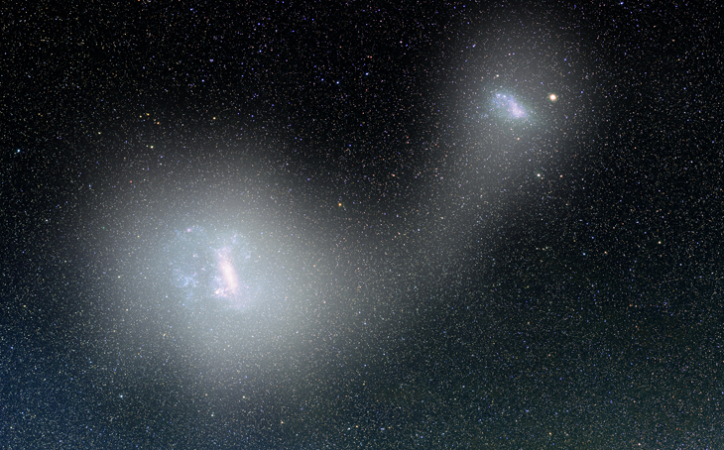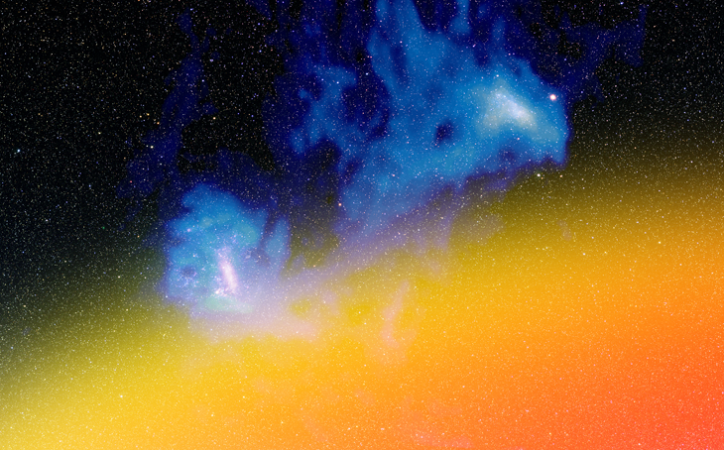Rivers of stars flow between ‘clouds’ orbiting the Milky Way
These stellar bridges hint at how the galactic clouds are interacting with each other and our Milky Way

The Milky Way arches across the night sky in this image, taken from Chile. The Large and Small Magellanic Clouds are in the center, just above the mountains.
D. Erkal/Cambridge University
Deep in space, two bridges made of stars link a pair of dwarf galaxies known as the Magellanic Clouds. Both clouds orbit our own galaxy, the Milky Way. Each of those “clouds” also is easily visible from Earth’s southern hemisphere. But this is the first time astronomers have seen streams of stars running between those clouds. The discovery is giving scientists clues to how galaxies interact and to the nature of the behavior of the Milky Way at its most distant edges.
“There have been hints that the clouds are connected. But no maps of the Magellanic [Maj-eh-LAN-ik] Clouds have shown these bridges of stars before,” notes Anthony Brown. He is an astronomer at Leiden Observatory in the Netherlands. He was not involved in the new research.
The discovery shows how a galaxy with a massive neighbor can get stretched, says study leader Vasily Belokurov. He is an astrophysicist at Cambridge University in England. A larger galaxy can pull a smaller nearby one apart. “We think we have uncovered signs that this is happening between the Large and Small Magellanic Clouds,” he says. His team shared its findings November 14 on arXiv.org.
The researchers discovered the bridges of stars in data from the Gaia spacecraft. This satellite’s mission is to map the locations of a billion stars in the Milky Way. Data from the first year of the mission was released to the astronomy community in September 2016. Belokurov and his colleagues took those data and looked at the brightness of each star that was mapped.
“Most stars are pretty constant. They are pretty well-behaved over time,” he says. But some stars aren’t so well-behaved. These stars get really bright. Then, they get really dim. Owing to this varying brightness, astronomers have come to call them variable stars.
Within the new data, Belokurov’s team found a stream of really old variable stars. These were flowing from the Small Magellanic Cloud to the Large Magellanic Cloud. Another scan of the data revealed a second stream. Made of young hot stars, this one also bridged the dwarf galaxies.
Story continues below image.

Streams in the sky
From Earth, the Magellanic Clouds appear to be separate groups of stars. But in the 1980s, scientists discovered a stream of hydrogen gas flowing between them. That stream hinted that the Magellanic Clouds were connected. The new discovery of stars streaming between them confirms that connection.
Strangely, the streams of stars don’t follow the same path from the smaller cloud to the larger one. The really old variable stars are closer to the Milky Way than the hot, young ones.
Why? Because our galaxy is a “big bully,” Belokurov says.
The Magellanic Clouds are crashing into our galaxy. They are now moving through an extended halo of hot, diffuse gas that envelops the Milky Way. As the Milky Way moves through the universe, this halo of gas generates a wind. The wind has little effect on the stars of the Magellanic Clouds. But it shoves around the gas in the dwarf galaxies. It pushes on the gas flowing between clouds,too.
That gas and the old variable stars probably got pulled out of the Small Magellanic Cloud and toward the Large Magellanic Cloud at the same time. It would have been a long time ago. Astronomers aren’t quite sure when that was, but they think it happened first. Then, the clouds and stream of gas and old stars slammed into the Milky Way.
During this collision, the stream of old stars didn’t budge. But the gas in the Milky Way pushed on the gas flowing between the Magellanic Clouds. It pushed the gas away from the Milky Way, separating that gas from the old stars. That second stream of hot, young stars then probably formed out of the streaming gas, the scientists now propose. This likely happened, they reason, because both the gas and the young stars are made of hydrogen.
“These kinds of galactic interactions are something we have only seen in [computer] simulations,” Brown says. “Now, we see it happening right in front of our eyes.”
Astronomers can use these interactions to probe the far reaches of our galaxy and solve a mystery. Matter is what gas, stars, galaxies and all the other stuff in the universe (including us) is made of. Matter comprises about 5 percent of the universe. But astronomers have only been able to find half of it. The discovery of the offset streams of stars could help to account for some of that “missing matter.”
To do so, astronomers can start by calculating the force the Milky Way used to ram and push away gas from the Magellanic Clouds. That force could then be used to calculate how close or far apart particles of gas are in the halo of the Milky Way. This would help calculate the density of the gas. That density would then say something about the mass of halo, and therefore the mass of the Milky Way, notes Ron Drimmel. He is an astronomer at the Observatory of Turin, in Italy. Although part of the Gaia team, he was not part of the new study.
That mass of the Milky Way, Belokurov notes, “could help pin down the density of our own galaxy and account for some of the missing matter that has been bothering astronomers for some time now.”








